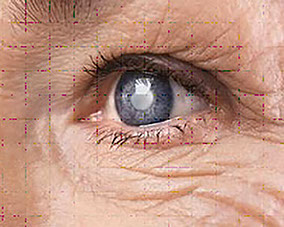What is a cataract?
Cataract occurs due to clouding of the lens inside the eye. Initially starting with a slight decrease in vision and focusing problems, the problems gradually deteriorate the quality of vision.
Why does a cataract occur?
Cataract, which mostly develops due to age, can also develop as a result of medication side effects such as long-term steroid use, or diseases such as diabetes affecting the eye. It can occur due to trauma. There are also rare congenital forms that develop in the womb.
What kind of complaints does cataract cause?
The most common complaints are the person’s eyeglass numbers changing in a short time, deterioration of distance vision, elimination of the need for glasses for near vision, excessive discomfort from strong lights such as car headlights, loss of brightness of colors, decreased night vision, and double vision.
How is cataract treated?
If the patient’s vision does not improve with the change of glasses, and if the cataract has reached a level that affects the patient’s quality of life, the treatment is surgery. Today, cataract surgery is most commonly performed with the phacoemulsification (phaco) method. A small incision is made to clean the cataract lens inside the eye with ultrasound waves, and then an artificial intraocular lens is placed through the same incision.
Is it possible to get rid of glasses with cataract surgery?
Although cataract surgery is the process of cleaning the patient’s cloudy lens (cataract) and replacing it with an artificial lens, with developing technologies it is possible to get rid of glasses completely or partially after cataract surgery. The artificial lens placed inside the eye can be produced in a way that also corrects the patient’s refractive errors thanks to today’s technology. Today, one of the aims of cataract surgery is to eliminate blurry vision and to help correct refractive errors such as myopia, hyperopia and astigmatism in the eye. Near vision deficiency is a condition that begins after the age of 40 in normal healthy individuals.

Which patients are suitable for multifocal lenses?
Although multifocal lenses seem very advantageous in theory, they may not be suitable for every patient. After surgery, there may be halos around point lights (such as lamps), problems with adaptation at intermediate distances, scattering and glare in lights such as sunlight or car headlights. These complaints are largely temporary and are expected to regress within 3 to 6 months. However, these complaints may be permanent in some patients. It has been reported that these complaints have been alleviated with the trifocal lenses developed in recent years, and that intermediate distance problems in particular have decreased. The most important issue regarding multifocal lenses is patient selection.
Suitable patient criteria for multifocal lenses (patients who will get better results, although there is no definite indication)
- Those who have a strong desire to get rid of glasses
- People who are not too critical, more ‘carefree’
- Those who do not expect very sharp near and far vision
- Those with hypermetropia or very high myopia
Negative patient criteria for multifocal lenses (patients who may be dissatisfied, although there is no definite indication)
- Those who do not worry much about using glasses after surgery and do not aim to get rid of glasses patients
- People who are overly critical and have unrealistic expectations
- Those who expect very sharp near and far vision
- People who were previously myopic (these patients usually have very good near vision and their vision quality may be below their expectations with multifocal lenses)
- Those who have to drive at night or work in jobs that require a lot of effort on the computer
- Patients with problems in the visual center (such as macular degeneration, macular edema due to diabetes)
Cataract surgery with multifocal/trifocal lenses is an extremely useful method with high patient satisfaction if the appropriate patient is selected. However, patient selection is an important factor here.
